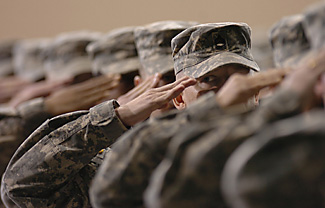| National Guard Congressional Report |
|
|
MODERNIZE U.S. RESERVE AND GUARD, FEDERAL PANEL SAYS
Deployments are up nearly fivefold since 2001, but they operate like a cold-war force.
By Gordon Lubold | Staff writer of The Christian Science Monitor
from the February 1, 2008 edition
WASHINGTON - Proposing what it called the first substantive reforms to the National Guard and Reserve in more than 50 years, a panel wants to refashion America's "weekend warriors" into an operational partner with the active-duty military.
That way, the reserve could be quickly mobilized to respond to a terrorist attack or natural disaster on the scale of a hurricane Katrina, says the Commission on the National Guard and Reserves, which released its 368-page report Thursday.
"We don't have the capacity remaining to deal with these homeland defense threats in an adequate way," says Marine Gen. Arnold Punaro (ret.), who headed the panel. "We have put our lives, our property, and our economy at greater risk because of that."
The commission proposed wholesale changes to better integrate the 1.2 million people in the Guard and Reserve with the Army, Navy, Air Force, and Marines. Among its 95 recommendations, the panel called for standardizing their training, providing them with more resources, and expanding the ability of the Pentagon to mobilize them. It also recommended that the general in charge of the National Guard Bureau in Washington receive a fourth star, a nod to the increasingly important role of that job. But it stopped short of saying he or she should become a member of the Joint Chiefs of Staff, a contentious proposal floated early on.
Reliance on reservists has increased dramatically since 2001, with deployments up nearly fivefold generally and, for some, such as the Army Guard and Army Reserve, up more than sevenfold. In 2004, nearly a third of all US forces in Iraq were guardsmen or reservists.
Partly as a result of that higher operational tempo, the Guard has suffered equipment shortages at home, preventing proper training in some cases, the panel said. General Punaro notes that 88 percent of the Army Guard combat units at home are not considered combat ready. Accordingly, the panel recommends boosting resources to the Guard and Reserve.
Congress created the commission in 2005 to look at the organization, training, and equipping of the military's reserve units and recommend changes that would help prevent the problems that arose after hurricane Katrina.
While the military's response was never the focal point of public criticism, the hurricane revealed a fundamental inability of federal and state agencies to coordinate efforts. With state governors and federal officials vying for command and control, it also pointed up that no one was in charge of the overall effort. The commission hopes to remedy this in part by enhancing control of governors for military forces operating within their state.
Some Reserve officials are upbeat about the panel's findings.
"There is every indication ... that they really have been successful in tackling some historically tough issues relating to getting from a cold war model of a strategic reserve to whatever it is we need for the future," says Marine Lt. Gen. John "Jack" Bergman, commander of Marine Forces Reserve in New Orleans. He says Congress and the Pentagon should pay close attention to its recommendations.
|
|
Printer-friendly format
|
|







